
Atlas F1 Technical Writer
The unique nature of the Monaco Grand Prix leads to many new parts being debuted at the Mediterranean circuit, giving an indication of the various teams' high downforce designs for the year. Atlas F1's Craig Scarborough analyses the changes seen during last weekend's race and reviews the cars' performance
But despite the history Monaco has changed; a new pit lane and pit garages have been added, as well as some new run off areas where none appeared before. While the pit lane changes were largely welcomed, aside from technical observers who enjoyed the old practice of the cars being worked on in the open air! The run off areas were criticised for taking some of the risk and excitement from the track. After the three serious race incidents, few can complain Monaco has gone soft.
Rear wings
Underbody Aerodynamics
As Monaco needs to get broken cars off the circuit as soon as possible, the cars are unceremoniously lifted from the track on cranes, allowing us to see the detail under the car in all its glory. While most of the aerodynamic work done under the cars creates a lot of the rear downforce for very little drag, the undersides of Formula One cars have not changed much in the past few years. Constrained by the regulations on widths and lengths, the teams have to make tiny changes to every curve to make gains. They are extremely secretive about the details of their floor, although to the naked eye most people couldn't tell one from the other!
Curved in Outer Channels
The shorter outer channel of the diffuser routes into the longer central tunnel; the tunnel is effectively longer, which helps pull air from under the sidepods.
Stepped Outer Diffusers
The outer diffuser tunnels start at the end of the flat bottom, rather than have a simple crease where the flat section curves up to form the diffuser; teams adopt a step, with either a square or round-over profile across this width. This acts like a gurney flap, and speeds up the flow either side of the intersection allowing for an even steeper diffuser, without fear of separation causing the diffuser to stall.
Shaped Suspension Arms and Lower Wing Beam
Since carbon fibre was adopted for suspension arms, and despite a ban on fully streamlined wishbones, teams have been able to place and shape wishbones and toe-links for aerodynamic gain, here we can see the roof of the outer diffuser channels are for all practical purposes extended by the shape of the toe-link, with the lower wing mount almost tripling the effective length of the tunnel.
Raised Outer Floor
Extra Ramp for the Centre Diffuser
Most teams use some sort of ramped extension where the flat section of the middle floor ends; this speeds the flow under the plank, which is the lowest part of the car.
Vortex Generator
Just to the side of the front splitter and level with the sidepods, Jaguar adopt a delta shaped fin. The vortex this produces trails along the step under the car, which is an aerodynamically difficult shape; the vortex adds speed to the flow, which eventually goes into the rear diffuser
Brake Ducts as Turning Vanes
With the sidepods adopting a coke-bottle shape the rear wheels created a square profiled obstruction; bodywork is not allowed between the rear wheels, but there is a lot of scope for the brake ducts to extend towards the centre line of the car. Here the oversize ducts can be seen quite clearly.
Team by Team
Ferrari
This layout improves rear wing performance, at the cost of some drag. It may be that this was Ferrari's high downforce solution, offsetting the extra drag for Monaco's demands on downforce; overall the cooling efficiency appears to be similar. There have also been suggestions that the angled shape of the chimney was itself used as a wing; this is doubtful, as presumably the extreme shape was simply the only method to get the chimney outlet in line with the winglet on Ferrari's slim sidepods.
Thursday's first session saw Ferrari amongst the fastest, then the usual drop in second qualifying. The team found the softer Bridgestone unable to last long enough to make it a suitable race tyre, so the harder option was chosen. In the race poor starts once more lost ground on the opening lap. Rubens Barrichello grounded the car, and after initially feeling it was a puncture the team noticed some suspension damage, causing him to take it easy for the balance of the race.
Michael Schumacher was caught among slower cars, and was also caught out when the safety car was deployed after Alonso's incident. He had too much fuel in his tank, limiting its capacity to make a pit stop last until the end of the race. His race was ended when he was warming his brakes through the tunnel and was hit by Montoya.
Renault
Fruits of their development process were seen in Monaco with the appearance of two novel solutions. Firstly the almost unnoticed bargeboards revisions, adding a flat axe shaped fin to the trailing edge of the boards; this appears to act like the Willis fin on the BAR and Williams, but it does not extend behind the bargeboard. Instead Renault has added an even larger vortex generator attached to the splitter behind the bargeboard.
Then there are the well-publicised winglets on the engine cover. Their advantage is almost impossible to gauge, as they are so narrow that the effect must be quite subtle. Since its launch the Renault R24 has had a crest on the spine of the engine cover; this always suggested a mid wing was to be added at some stage, but none ever appeared. Now two aerofoil sections have been added; a narrow one at the front, and behind and slightly above that an even smaller one.
As with all these mid wings they do not use endplates, so they lose a lot of downforce in the spillage of high pressure air above passing under the wing; this does have the benefit of creating a weaker tip vortex, but with Renault's wings being so narrow they would appear to offer neither sufficient downforce or flow redirection. This set up has been supplemented by a shelf wing far more complex in its shaping than that of the other teams; Renault's version has three distinct chord changes across each span, while the trailing edge remains straight. It could be interpreted that the wing acts to collect the different oncoming flows and straightens them in advance of the rear wing.
It has also been suggested that Renault have problems with the stiffness of their chassis, creating the unpredictable feel the drivers have complained of. While no pictures have confirmed it, it is believed that Renault has reinstated the strengthening struts between the gearbox and chassis, as appeared on the wide angle, low line engined cars, and that since this addition the car's handling has improved.
Both opening days went without drama for the team, with the R24 working very well over the bumps and without the understeer in the slow corners exhibited by almost every other team. From pole Jarno Trulli ran a clean race to the finish, while Fernando Alonso followed up without problems until he hit the barrier lapping Ralf Schumacher through the tunnel. Overall the team worked with an ideal car and almost error free driving.
BAR
The team's usual Friday competitiveness was repeated in Monaco's Thursday sessions, with the team reporting no problems. Qualifying also looked good for the team, with only Takuma Sato's error over the kerbs costing him a better grid slot. A positive weekend continued at the start of the race, with Sato making an incredible start, but his race unfortunately ended before he could make more progress or have his start investigated by the stewards. His engine started smoking over the opening laps and eventually blew up along the sea front, leading to the Fisichella/Coulthard accident; the engine failure was not predicted, and was believed to have been caused by overheating at the restart. Meanwhile Jenson Button had a clean race, only held up occasionally by backmarkers, to another second place finish.
Williams
Having run at previous races, Williams' shelf wing made another appearance but was supplemented by a mid wing for the first time, all aimed at redirecting the flow to the rear wing, which was working near its maximum dimensions and angle of attack at Monaco.
Once again the team ran small struts reinforcing the low horizontal fins (water wings, as BAR call them) in front of the sidepods. Clearly the struts are only for reinforcing the thin fins, but this in itself raises questions on Williams need to run them; flexing would be both against the rules and undesirable, as the flow and tip vortex from the fin would shift vertically.
This raises one theory that Williams are unable to run the level of ballast that they would like, as a consequence of the heavy twin keel and walrus nose set up. To make the floor stiffer to prevent flex would be easily achievable, probably without the need for new moulds, so the reason for the weight efficient struts could be to prevent the loss of tuning ballast.
Thursday saw the team chasing a better set up, and Ralf Schumacher's engine failure further added to their problems. Qualifying saw Juan Pablo Montoya overdrive the car and lose time in the slower corners, while Schumacher's cleaner lap placed him in provisional second on the grid before his ten position engine change penalty, and was probably more down to his fuel load than the cars inherent pace.
Schumacher's technical maladies started quite early in the race with the loss of fifth gear; the other high gears leaving him with only fourth by the time of his incident with Alonso. Montoya had a technical drama free race; only his contact with Michael Schumacher causing problems, but fortunately no damage was made to the car during the incident.
McLaren
As Monaco requires a much tighter turning circle the team introduced some change to the power steering rack, which lead to some problems on Thursday, but otherwise the team found the car more competitive on the street circuit. Qualifying went equally as well, with only driver errors costing them time. After a good showing on the opening days the race ended in disappointment, with David Coulthard involved in the Sato blow up; the team was unable to repair the car without a restart (the safety car was deployed); Kimi Raikkonen's race was cut short when telemetry reported an impending failure with the engines pneumatic system.
Jaguar
Disasters on Thursday started a bad weekend for Jaguar, with Webber's oil pressure failure stopping him on track and leading to a major fire, from which the engine was salvaged at the cost of no further running that day. Meanwhile an electrical problem lead to an incident for Christian Klien. Saturday also saw technical problems forcing Webber into the spare chassis, but both drivers recovered to post solid qualifying laps.
These good laps meant nothing when in the race Klien knocked his front wing off, which stuck under his wheels and lead to his crash at the hairpin, while Webber had a hydraulic failure, stopping him on track.
Sauber
All weekend the team struggled with the softer Bridgestones, which after one good lap started to grain, particularly at the rear; this did lead to good grid positions, but with Giancarlo Fisichella involved in the accident with Coulthard it was left to Felipe Massa to struggle with fading tyres to finish in the points in fifth.
Toyota
With no visible developments being brought to the race, it was no surprise to find the cars struggling with their perennial problem of poor rear grip and control over kerbs; the drivers found a balance, but not speed. For the race strong drives by both drivers reversed their fortunes, despite the false start initiated by Olivier Panis and Cristiano da Matta's clutch problems at the start and in his pit stop. Olivier also suffered brake problems in the race, but was able to bring the car home in the points.
Jordan
Jordan retained the mid wing that appeared in Spain, but little other aerodynamic development was evident. Both drivers spent Thursday setting up the car and learning the track, with Nick Heidfeld suffering technical problems with his brakes. Qualifying saw Giorgio Pantano less happy with the car, and in the race his gearbox had a downshift problem, leaving him in fourth gear, While Heidfeld had two strategic pit stops under the safety car to propel him to an eventual seventh place and the first points for the team this year.
Minardi
Minardi tried a mid-wing for the first time, but it was not run after Thursday as it provided no advantage. Incidents were strewn all over the free practice sessions, with Zsolt Baumgartner hitting the barriers twice and Gianmaria Bruni's once; the qualifying laps were also strewn with errors. In the race Bruni's car failed to leave the grid cleanly and eventually retired with the loss of gears; Baumgartner ran a conservative race to finish several laps down and just out of the points.
Monaco is the quintessential street circuit, run on real roads with tight corners and ever present barriers. The demands on downforce and mechanical grip are the same as ever at Monaco. The track features a long curve through the tunnel, and reaching a high speed though this section is as crucial to good lap times as through the slower sections. With the European summer just starting and the barrier lined track retaining heat, cooling is also an issue for the teams, and several revisions were introduced for the teams that lacked an efficient cooling package.
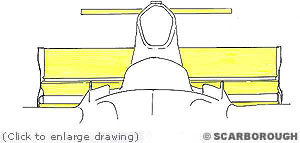 With rear wings trimmed for 2004, the requirement to add more downforce with out concern for drag tested the teams. Most teams have now adopted a pair of wings mounted forward of the rear wing; either low, just ahead of the rear wheels known as a shelf wing, or high up on the roll structure and termed a mid wing. These devices don't actually act as wings in the conventional sense, they are largely used for turning the airflow toward the rear wing, making the rear wing appear steeper to the oncoming airflow than the regulations allow.
With rear wings trimmed for 2004, the requirement to add more downforce with out concern for drag tested the teams. Most teams have now adopted a pair of wings mounted forward of the rear wing; either low, just ahead of the rear wheels known as a shelf wing, or high up on the roll structure and termed a mid wing. These devices don't actually act as wings in the conventional sense, they are largely used for turning the airflow toward the rear wing, making the rear wing appear steeper to the oncoming airflow than the regulations allow.
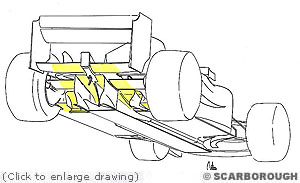 From the series of drawings of the Jaguar we can see some of the development used to improve the function of the floor.
From the series of drawings of the Jaguar we can see some of the development used to improve the function of the floor.
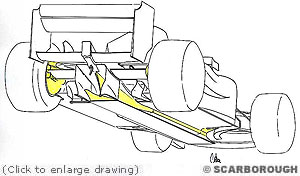 Pioneered by Williams, the otherwise wasted pieces of floor between the wheels and diffuser are slightly raised to form their own diffuser. These outer sections of floor also often feature fences and fins to manage the trailing flow from the wheels, upsetting the diffuser's wake.
Pioneered by Williams, the otherwise wasted pieces of floor between the wheels and diffuser are slightly raised to form their own diffuser. These outer sections of floor also often feature fences and fins to manage the trailing flow from the wheels, upsetting the diffuser's wake.
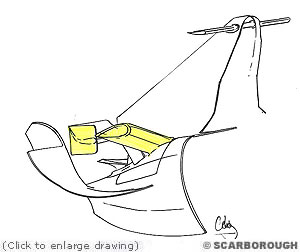 As seen in testing during the build up to the race, Ferrari debuted a new cooling outlet arrangement. Recent Ferraris have adopted the infamous shark gills on the shoulders of the sidepods, feeding the heated air out close to the bodywork towards the rear of the car. For Monaco unusual angled chimneys were fitted to the same aperture in the sidepods; as with all chimney outlets they aim to throw the flow clear either side of the rear wing, by interacting with the vortex trailing from the larger endplate on the winglet.
As seen in testing during the build up to the race, Ferrari debuted a new cooling outlet arrangement. Recent Ferraris have adopted the infamous shark gills on the shoulders of the sidepods, feeding the heated air out close to the bodywork towards the rear of the car. For Monaco unusual angled chimneys were fitted to the same aperture in the sidepods; as with all chimney outlets they aim to throw the flow clear either side of the rear wing, by interacting with the vortex trailing from the larger endplate on the winglet.
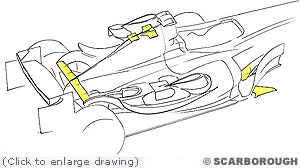 In contrast to the other front running teams at Monaco (BAR and Ferrari), Renault adopted a highly complex approach to their aerodynamics. Continuing investment in their windtunnel, as well as in rapid prototyping tools such as stereo laser lithography or laser sintering, the team are able to quickly design and produce a part for windtunnel and track testing.
In contrast to the other front running teams at Monaco (BAR and Ferrari), Renault adopted a highly complex approach to their aerodynamics. Continuing investment in their windtunnel, as well as in rapid prototyping tools such as stereo laser lithography or laser sintering, the team are able to quickly design and produce a part for windtunnel and track testing.
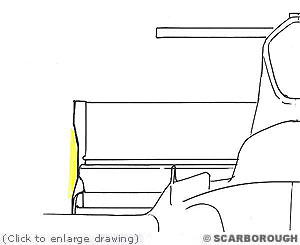 While everyone else was copying BAR's format of shelf wing and mid wing (termed by BAR a Type "R" wing after Hondas spoilered road cars) BAR opted to use the wider of their mid wings. In addition to the extra wings, the rear wing used a straight profile, accepting a drag penalty for more downforce. The rear wing endplate also sported the shaping from their normal wing, and was also seen on the McLaren. The front vertical edge of the endplate was pinched in where the main plane starts; it's debateable if this aids the aerodynamics drag management or yaw performance.
While everyone else was copying BAR's format of shelf wing and mid wing (termed by BAR a Type "R" wing after Hondas spoilered road cars) BAR opted to use the wider of their mid wings. In addition to the extra wings, the rear wing used a straight profile, accepting a drag penalty for more downforce. The rear wing endplate also sported the shaping from their normal wing, and was also seen on the McLaren. The front vertical edge of the endplate was pinched in where the main plane starts; it's debateable if this aids the aerodynamics drag management or yaw performance.
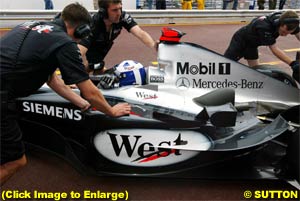 After much testing at Paul Ricard, and the completion of the first MP4-19B chassis, McLaren appeared with several little tweaks on the car. These largely centred on the sidepods, with a revised shape and a grill covering the area around the exhausts in lieu of the normal apertures cut into the sidepods for hot races. As with BAR they use a pinched rear wing endplate.
After much testing at Paul Ricard, and the completion of the first MP4-19B chassis, McLaren appeared with several little tweaks on the car. These largely centred on the sidepods, with a revised shape and a grill covering the area around the exhausts in lieu of the normal apertures cut into the sidepods for hot races. As with BAR they use a pinched rear wing endplate.
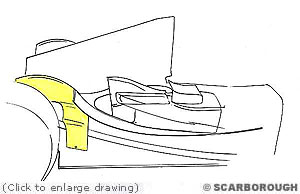 Mark Webber's engine fire on Thursday gave away the Jaguar's under floor secrets; I had not previously picked up the more visible change to the flip ups that appeared in Spain. Where as the previous bodywork on the Jaguar necessitated a strut to support the load on the flip up, the new set up replaces the rod with a flat turning vane. The vane is curved to match the contours of the wheel and sidepod, which probably helps protect the flow heading over the top of the diffuser from being upset by the wheels.
Mark Webber's engine fire on Thursday gave away the Jaguar's under floor secrets; I had not previously picked up the more visible change to the flip ups that appeared in Spain. Where as the previous bodywork on the Jaguar necessitated a strut to support the load on the flip up, the new set up replaces the rod with a flat turning vane. The vane is curved to match the contours of the wheel and sidepod, which probably helps protect the flow heading over the top of the diffuser from being upset by the wheels.
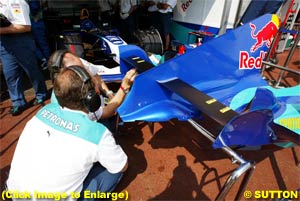 While accusations of Ferrari copying still persist, Sauber appears with a long chord shelf wing, something Ferrari have yet to race with (their version from winter testing used a very short chord). As Sauber use a one piece engine cover without a separate piece for the gearbox the wing does not need to be removed, which makes servicing the car easier.
While accusations of Ferrari copying still persist, Sauber appears with a long chord shelf wing, something Ferrari have yet to race with (their version from winter testing used a very short chord). As Sauber use a one piece engine cover without a separate piece for the gearbox the wing does not need to be removed, which makes servicing the car easier.
|
Contact the Author Contact the Editor |
Please Contact Us for permission to republish this or any other material from Atlas F1.
|
Volume 10, Issue 21
Atlas F1 Exclusive
Interview with Patrick Head
Bjorn Wirdheim: Going Places
Ann Bradshaw: Point of View
2004 Monaco GP Review
2004 Monaco GP Review
Technical Review: Monaco
Tunnel Vision
2004 European GP Preview
2004 European GP Preview
European GP Facts & Stats
Stats Center
Qualifying Differentials
SuperStats
Charts Center
Columns
The F1 Insider
Season Strokes
On the Road
Elsewhere in Racing
The Weekly Grapevine
> Homepage |